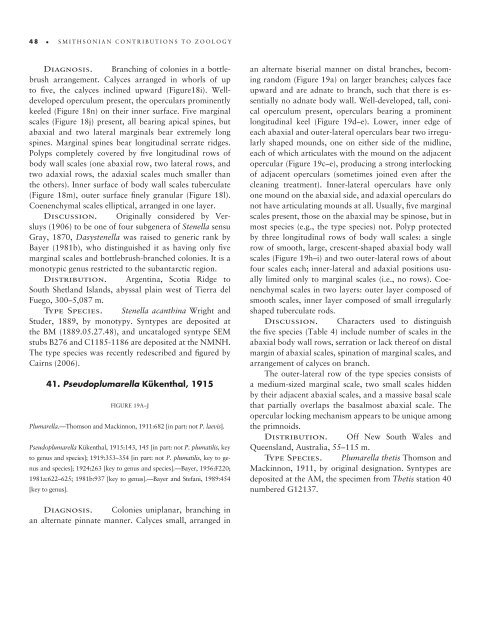A Generic Revision and Phylogenetic Analysis of the Primnoidae
A Generic Revision and Phylogenetic Analysis of the Primnoidae
A Generic Revision and Phylogenetic Analysis of the Primnoidae
Create successful ePaper yourself
Turn your PDF publications into a flip-book with our unique Google optimized e-Paper software.
48 SMITHSONIAN CONTRIBUTIONS TO ZOOLOGY<br />
Diagnosis. Branching <strong>of</strong> colonies in a bottlebrush<br />
arrangement. Calyces arranged in whorls <strong>of</strong> up<br />
to fi ve, <strong>the</strong> calyces inclined upward (Figure18i). Welldeveloped<br />
operculum present, <strong>the</strong> operculars prominently<br />
keeled (Figure 18n) on <strong>the</strong>ir inner surface. Five marginal<br />
scales (Figure 18j) present, all bearing apical spines, but<br />
abaxial <strong>and</strong> two lateral marginals bear extremely long<br />
spines. Marginal spines bear longitudinal serrate ridges.<br />
Polyps completely covered by fi ve longitudinal rows <strong>of</strong><br />
body wall scales (one abaxial row, two lateral rows, <strong>and</strong><br />
two adaxial rows, <strong>the</strong> adaxial scales much smaller than<br />
<strong>the</strong> o<strong>the</strong>rs). Inner surface <strong>of</strong> body wall scales tuberculate<br />
(Figure 18m), outer surface fi nely granular (Figure 18l).<br />
Coenenchymal scales elliptical, arranged in one layer.<br />
Discussion. Originally considered by Versluys<br />
(1906) to be one <strong>of</strong> four subgenera <strong>of</strong> Stenella sensu<br />
Gray, 1870, Dasystenella was raised to generic rank by<br />
Bayer (1981b), who distinguished it as having only fi ve<br />
marginal scales <strong>and</strong> bottlebrush-branched colonies. It is a<br />
monotypic genus restricted to <strong>the</strong> subantarctic region.<br />
Distribution. Argentina, Scotia Ridge to<br />
South Shetl<strong>and</strong> Isl<strong>and</strong>s, abyssal plain west <strong>of</strong> Tierra del<br />
Fuego, 300–5,087 m.<br />
Type Species. Stenella acanthina Wright <strong>and</strong><br />
Studer, 1889, by monotypy. Syntypes are deposited at<br />
<strong>the</strong> BM (1889.05.27.48), <strong>and</strong> uncataloged syntype SEM<br />
stubs B276 <strong>and</strong> C1185-1186 are deposited at <strong>the</strong> NMNH.<br />
The type species was recently redescribed <strong>and</strong> fi gured by<br />
Cairns (2006).<br />
41. Pseudoplumarella Kükenthal, 1915<br />
FIGURE 19A–J<br />
Plumarella.—Thomson <strong>and</strong> Mackinnon, 1911:682 [in part: not P. laevis].<br />
Pseudoplumarella Kükenthal, 1915:143, 145 [in part: not P. plumatilis, key<br />
to genus <strong>and</strong> species]; 1919:353–354 [in part: not P. plumatilis, key to genus<br />
<strong>and</strong> species]; 1924:263 [key to genus <strong>and</strong> species].—Bayer, 1956:F220;<br />
1981a:622–625; 1981b:937 [key to genus].—Bayer <strong>and</strong> Stefani, 1989:454<br />
[key to genus].<br />
Diagnosis. Colonies uniplanar, branching in<br />
an alternate pinnate manner. Calyces small, arranged in<br />
an alternate biserial manner on distal branches, becoming<br />
r<strong>and</strong>om (Figure 19a) on larger branches; calyces face<br />
upward <strong>and</strong> are adnate to branch, such that <strong>the</strong>re is essentially<br />
no adnate body wall. Well-developed, tall, conical<br />
operculum present, operculars bearing a prominent<br />
longitudinal keel (Figure 19d–e). Lower, inner edge <strong>of</strong><br />
each abaxial <strong>and</strong> outer-lateral operculars bear two irregularly<br />
shaped mounds, one on ei<strong>the</strong>r side <strong>of</strong> <strong>the</strong> midline,<br />
each <strong>of</strong> which articulates with <strong>the</strong> mound on <strong>the</strong> adjacent<br />
opercular (Figure 19c–e), producing a strong interlocking<br />
<strong>of</strong> adjacent operculars (sometimes joined even after <strong>the</strong><br />
cleaning treatment). Inner-lateral operculars have only<br />
one mound on <strong>the</strong> abaxial side, <strong>and</strong> adaxial operculars do<br />
not have articulating mounds at all. Usually, fi ve marginal<br />
scales present, those on <strong>the</strong> abaxial may be spinose, but in<br />
most species (e.g., <strong>the</strong> type species) not. Polyp protected<br />
by three longitudinal rows <strong>of</strong> body wall scales: a single<br />
row <strong>of</strong> smooth, large, crescent-shaped abaxial body wall<br />
scales (Figure 19h–i) <strong>and</strong> two outer-lateral rows <strong>of</strong> about<br />
four scales each; inner-lateral <strong>and</strong> adaxial positions usually<br />
limited only to marginal scales (i.e., no rows). Coenenchymal<br />
scales in two layers: outer layer composed <strong>of</strong><br />
smooth scales, inner layer composed <strong>of</strong> small irregularly<br />
shaped tuberculate rods.<br />
Discussion. Characters used to distinguish<br />
<strong>the</strong> fi ve species (Table 4) include number <strong>of</strong> scales in <strong>the</strong><br />
abaxial body wall rows, serration or lack <strong>the</strong>re<strong>of</strong> on distal<br />
margin <strong>of</strong> abaxial scales, spination <strong>of</strong> marginal scales, <strong>and</strong><br />
arrangement <strong>of</strong> calyces on branch.<br />
The outer-lateral row <strong>of</strong> <strong>the</strong> type species consists <strong>of</strong><br />
a medium-sized marginal scale, two small scales hidden<br />
by <strong>the</strong>ir adjacent abaxial scales, <strong>and</strong> a massive basal scale<br />
that partially overlaps <strong>the</strong> basalmost abaxial scale. The<br />
opercular locking mechanism appears to be unique among<br />
<strong>the</strong> primnoids.<br />
Distribution. Off New South Wales <strong>and</strong><br />
Queensl<strong>and</strong>, Australia, 55–115 m.<br />
Type Species. Plumarella <strong>the</strong>tis Thomson <strong>and</strong><br />
Mackinnon, 1911, by original designation. Syntypes are<br />
deposited at <strong>the</strong> AM, <strong>the</strong> specimen from Thetis station 40<br />
numbered G12137.

















